Only 25.9% of internet users use the English language, which means more than 70% of users surf the internet in other languages. And if your website serves content only in the English language, it may be failing to receive and engage a massive portion of the global organic traffic.
So, how do you optimize your website so that it can rank for searches performed in different languages and gain increased organic traffic? The simple answer is: Multilingual SEO.
What is multilingual SEO? Should you go for it? If yes, how? In this article, you will find answers to these questions and more as we explore the what, why, and how of multilingual SEO.
So, let’s dive right in!
What is multilingual SEO, and how does it increase organic traffic?
Multilingual SEO is a sub-type of the regular SEO that we have all come to know. This practice involves translating your website into the language you want to target and optimizing it for SEO for that language.
Search engines love to keep their users satisfied. Therefore, they go to the end to ensure that the search results answer the users’ query.
So, if a person searches for something in Portuguese, Google will yield results based on websites that offer relevant content in Portuguese.
Now, how can it bring organic traffic? Let’s answer this question with an example.
Say you run a business with your target audience being in the US and Germany. Your website is built in English with no multilingual SEO and ranks for English keywords only. Everything seems to be working well.
But what happens when one of your German customers performs a search in their native language?
Since your website isn’t optimized for multilingual searches, Google won’t match the query with the content on your page. Hence, your website will not rank for this multilingual search. Consequently, the multilingual searchers will be directed elsewhere, and that could’ve been your web traffic, diverted to a website that speaks in their preferred language.
So, by optimizing your website for multilingual searches, you open doors for global traffic to your website. That’s how multilingual SEO serves to increase organic web traffic.
What is multiregional SEO?
Multiregional SEO is a practice similar to multilingual SEO, instead of optimizing a website to rank for different languages, it optimizes a web page to rank for searches from a specific geographical location.
For example, if your business expands from the US to Germany and Portugal. Then you may want to optimize your website to rank its location-specific variations for international searches. So that a person searching for your brand from Portugal will see the Portuguese version of your website while one searching from Germany will see the German version.
Take Nike, for example. It is a massive global brand with customers all over the world. To ensure that each of its customers sees location-appropriate information, such as product description, price in their native currency, product availability, etc. Nike has multiple versions of its website.
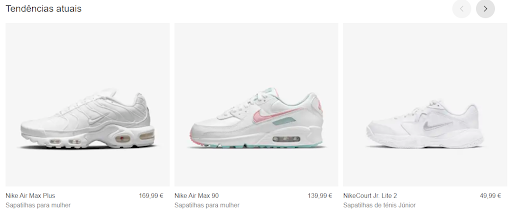
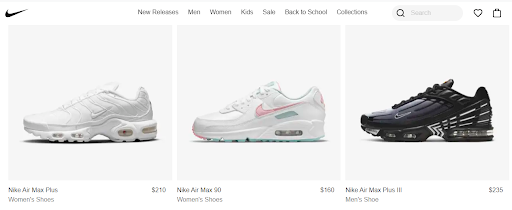
Nike’s websites are optimized for multiregional and multilingual searches. Can you imagine the reach?
Should you do multilingual SEO for your website?
Doing multilingual SEO is not as easy as translating your website content using online translation services such as Google Translate and pasting translated versions of text on your new webpages. Sorry to burst your bubble there but optimizing your website for multilingual searches is quite a bit more complicated, as we will see in detail.
So, the question is, should you go for it?
Let’s look at a case study to see if Multilingual SEO is any good.
Pet care supplier Hill’s Pet got its website optimized for 15 different languages to globalize its reach. They posted bespoke content and carried out a proper multilingual SEO campaign and the results were surprisingly impressive. Their organic traffic from France grew by 529% and from Holland, they received 340% more people. This effort brought 208% increased organic traffic from Poland, 149% increased traffic from Germany, and 107% increased traffic from Italy.
Now, before you get starry-eyed by Hill’s Pet’s case study, sometimes multilingual SEO gets complex and expensive. And your business strategy should be clearly defined, as if it worked for them, that doesn’t mean it would work for you.
So, take a step back before diving nose into optimizing your website for multilingual searches.
It is important to find out if your website receives some sort of traffic from different geographic regions. If it doesn’t, multilingual SEO will do you no good.
You should consider an additional budget for multilingual SEO, which may require additional keyword analysis and translations from native translators, unless you are fluent in that language.
[Case Study] How business-oriented SEO increases traffic and conversions
How to do multilingual SEO for increased organic traffic?
As mentioned a few times now, multilingual SEO is not as easy as it may seem but could bring potential traffic growth to your site. There is a lot you should know before you can even begin to understand its technicality.
Let’s look at the technicalities and the information you needed to start your multilingual SEO journey.
1. Start with a Plan
“Planning to fail is failing to plan,” said Benjamin Franklin. This adage extends to multilingual SEO as well.
As you decide to optimize your website for various languages, you must start with a plan.
Translating and optimizing the website for multiple languages is complex, time-consuming, and cost-intensive. So, you should translate your website only into those languages that are promising in terms of traffic.
For example, if Spanish-speaking people form a majority of your web traffic, then translating in French will be a waste of investment.
Therefore, we should know well beforehand what languages to optimize for.
You cannot just assume the language of your audience. For example, if you receive good traffic from the US you could not assume people only speak English, there could be a good number of people living in the US who speak Spanish as well as English.
Pinpoint exactly what language your web searchers are using. A good way to do this is to dive into your website’s analytics and see what language searches or keywords drive the most traffic. You can also sneak into your competitors and see what languages they have targeted.
Once you have decided on the language, it’s time to move on.
2. Keyword Analysis
You should carry out an independent keyword research process for each language you translate your website into. Why? Because a keyword that seems promising in one language may not be so viable when translated into another.
As an example, consider the screenshot below.
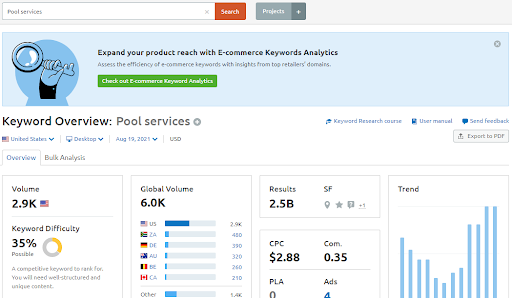
Source – semrush keyword tool
We searched for the keywords “Pool Services” in the United States, which has a significant search volume. But when the same words are translated into Spanish, the search volume significantly drops.
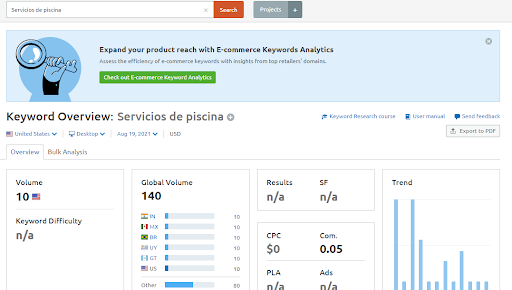
That doesn’t mean people aren’t searching for it in Spanish, they must be using Spanish because it is the second biggest language in the US. It means people are using keywords other than a direct translation of “Pool Services.” Like “servicio de limpieza y mantenimiento de piscinas” which is translated from swimming pool cleaning and maintenance services has relatively better results than the direct translation of “Pool Services.”
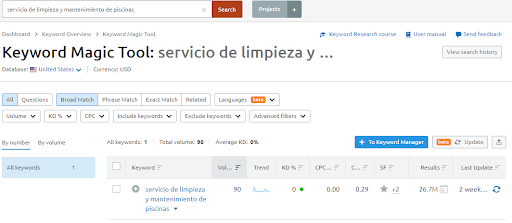
So, brainstorming keyword ideas in your target language and using keyword analysis tools to find out each keyword’s search volume and competition is very important. Then use the keywords with high search volumes and low competition when translating your content.
3. Translating the Content
We have strategically placed keyword analysis before translation because we believe translating the content with keywords on hand is a better approach.
Use a human translator for translating your website content. Robot translators might have evolved significantly. However, they still can’t match the human ability to adapt the translated content according to the culture and sentiments associated with a language.
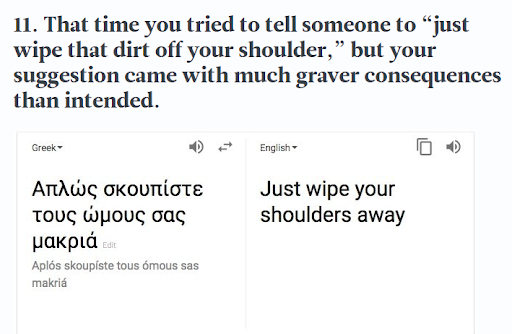
Image Source: Babble.com
See what we mean?
The quality of content relates to user experience, which is a critical ranking factor now. So, you must ensure that your translated content reads smoothly and can be relevant for the users to keep them engaged.
For example, your Spanish-speaking users might not relate to the instance you used in your English content to engage your English-reading users. Therefore, it is best to either hire native translators for translating the content. Or have native speakers proofread the automatically translated content.
Additionally, Google itself recommends against using auto-translators.

Image Source: Google
4. URL Structure
Once you have covered the content part, it’s time to get a bit more technical. Let’s look at the technical aspect of the website structure through URLs.
Choosing the right URL structure is the most important aspect of your SEO strategy. You have to make sure each version of your website has its own URL. Google itself recommends using different URLs for each language page on your website.
When it comes to URLs, you have five choices. We will explore all of these and finish off with what the experts recommend and advice against using.
ccTLD
ccTLD or country-code top-level domain is a URL structure that ends with country specific ccTLD for e.g .fr stands for France, .ca stands for Canada or .de stands for Germany etc. With a ccTLD, your website may look something like this:
examplesite.ca
examplesite.fr
examplesite.co.uk
examplesite.de
Using this URL structure has its pros and cons.
Search engine results for multiregional searches are more accurate with this URL structure because Google sees such URLs as independent websites. If your brand has associated .com or other related TLD as primary website address, you could be diluting the domain authority by having multiple country specific TLDs or simply your site authority from your core domain may not extend to the new website.
gTLD with Subdomain
A generic TLD or gTLD with a sub-domain may look something like:
fr.examplesite.com
de.examplesite.com
en-gb.examplesite.com
gTLD with a subdomain is also considered an independent URL and hence cannot hitch a ride on the authority of the core domain. Additionally, it is less user-friendly and therefore not often recommended.
gTLD with subdirectory
A generic TLD with subdirectories included in the same core domain is the most recommended option for URL structures when doing multilingual SEO. With this URL, all language pages come under one domain and can borrow the authority of the core domain.
It looks something like this:
examplesite.com/fr-ca
examplesite.com/en-ca
examplesite.com/es-es
Experts recommend using this URL structure, with language followed by the region (fr-ca) for your multiregional and multilingual SEO efforts.
gTLD with Parameters
In a URL structure with gTLDs and parameters, the domain is often followed by a parameter that looks something like this ?lang=ca
This URL structure is the least user-friendly and hence not recommended by any SEO expert.
5. Hreflang Tag
The Hreflang tag is an HTML attribute that can help you avoid getting penalized when doing multilingual SEO. So, it is important.
When you translate your web content, Google may see two versions as duplicates and may penalize the domain. Hreflang tells the search engine that these pages are not duplicate but alternates of each other.
Additionally, Hreflang also helps search engine crawlers identify which version of your website to rank for a given search.
The Hreflang tag goes into the code of your website. You usually have three options when it comes to inserting the attribute on your website:
Insert the Hreflang tag in the head of your HTML.

Insert the Hreflang tag in the HTTP header if you have a non-HTML website, like PDF, etc.

Insert the Hreflang tag in the XML Sitemap.
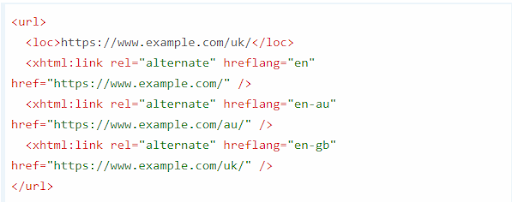
When inserting Hreflang tags, it is also important to insert the Hreflang x-default tag. This tag helps search engines identify which page to display in case the search does not match any of the website’s versions.
6. Multilingual Content Marketing
As you have translated your website and have optimized it, now you must be thinking that your website should flood with traffic, right? Unfortunately, that’s not how it works. You have to carry out an independent content marketing campaign, just like you would for your regular website, to see traffic.
You should run a link-building campaign to acquire links from high-authority websites to language specific landing pages of your website. But make sure you link to the websites that have the content in the same language as the one you are targeting. For example, your German website should have links from another high authority German website. This will bring regional traffic as well as improve the page authority as well as increase the domain strength.
Additionally, it is recommended that keeping content fresh on the multilingual pages is very important to ensure that they do not lose authority in the eyes of the search engines.
Conclusion
Multilingual SEO can be a gateway of international traffic to your website. Many websites have seen tremendous growth in traffic by optimizing their website to rank for multilingual searches.
But other’s success should not be your reason to invest in it. It could be expensive, and time-consuming if not aligned with your business goals. Additionally, a multilingual website is difficult to maintain. Therefore, only get into it if you can see your business acquiring tangible benefits from catering to multilingual users.
Performing independent keyword analysis and choosing your target language wisely are primary steps to start with.

